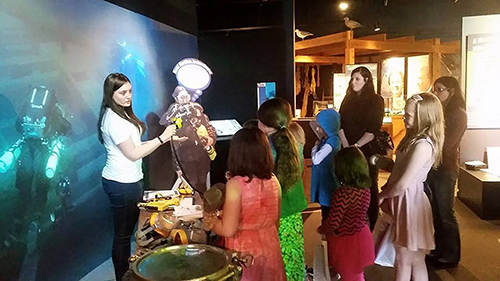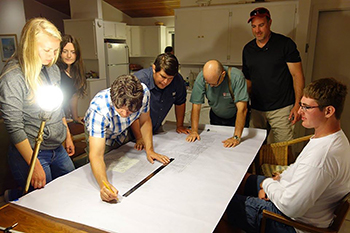Wisconsin Historical Society archaeologists lead Wisconsin Sea Grant-funded effort
A century ago, Lake Michigan was a busy water highway for the lumber trade, connecting merchants in northern Wisconsin and Michigan with customers in bustling cities like Milwaukee and Chicago. While this Great Lakes lumber trade persisted into the 1920s and ‘30s, it peaked in the late 1800s. At one time, about 500 vessels traversed Lake Michigan as part of this trade, before rail and eventually trucking took over.
Shipwrecks help tell the story of the Great Lakes lumber trade. The Wisconsin Historical Society’s (WHS) highly active program in maritime archaeology documents these and other wrecks and shares its findings through a variety of educational efforts.
Now, through funding from Wisconsin Sea Grant, WHS is embarking on a new, two-year project called “Boatloads of Lumber.” One key outcome will be online learning resources tailored to a range of ages. WHS Maritime Archaeologists Caitlin Zant and Tamara Thomsen will lead the project, which also involves Wisconsin Sea Grant’s Anne Moser, who oversees the Wisconsin Water Library and education activities.

Caitlin Zant talks to Girl Scouts at the Wisconsin Maritime Museum about shipwrecks and the aquatic sciences. (Photo: Wendy Lutzke)
Said Zant, “Our program [at the Historical Society] does a lot of outreach and education, but a lot of it is focused on public presentations to a broad audience, and not really working as closely as we might with museum educators to create programming and activities for kids of all ages.”
Zant said requests have been increasing to speak to groups like 4-H, Boy Scouts and Girl Scouts.
Although this project, a part of Sea Grant’s 2020-22 funding cycle, has been in the planning stages for quite some time, the current COVID-19 pandemic and rapid shift to online instruction has made it even more relevant.
Said Zant, “Especially with recent events, everyone’s clamoring for this kind of content that anyone can teach to kids, to keep education going no matter what the age or no matter what the circumstances.”
The online resources will be developed in concert with museum educators, including those at museums devoted to maritime history. Collaborators include the Wisconsin Maritime Museum in Manitowoc, the Port Exploreum in Port Washington and the Door County Maritime Museum’s locations in Sturgeon Bay and Gills Rock.
By end of year one, Zant said that museum educators will have tested draft versions of the new resources. Feedback from the educators will help the team refine the tools, and final versions will be ready by the end of year two.
Sea Grant’s Moser will help ensure that the tools convey a cohesive message in terms of Great Lakes literacy. Shipwrecks can be a way for learners of all ages to connect with other issues affecting the Great Lakes, from aquatic invasive species and water quality to currents and sand movement.
Diving into history
A second key aspect of the “Boatloads of Lumber” project is a field school to help recreational divers and archaeology enthusiasts learn techniques to properly survey and document wrecks they may find.

After a day of diving and collecting data, students in the 2015 field school work on the site plan of the shipwreck Grape Shot. (Photo: Tamara Thomsen, Wisconsin Historical Society)
As Zant noted, her office at WHS does not go out in search of shipwrecks, generally speaking. However, they do get valuable tips from members of the public when shifting sands and varying water levels uncover parts of a wreck. With training, history buffs and divers can learn more about maritime archaeology skills like how to draw underwater.
WHS first tried a field school approach in the late 1990’s and has done so with more frequency since 2015. A 2015 collaboration with the Wisconsin Underwater Archaeology Association on a wreck in Door County was a great success.
For the current grant project, the focus will be on the Sidney O. Neff, a wooden vessel built in 1890 by a Manitowoc company. It sank in 1939 with no loss of life. Now it lies, heavily covered by invasive quagga mussels, in about 12 feet of water near the Marinette lighthouse.
Said Zant, “The Sidney O. Neff is well suited for learning because it is in a relatively protected area” with fairly shallow water. “Over the course of the project, students can come up out of the water and ask questions. We try to make [the field school] as safe an environment as possible. Sometimes people are working underwater for the first time.”
The Minnesota-based Great Lakes Shipwreck Preservation Society has been a key partner in these field schools and will also participate in the Sidney O. Neff project.
Wisconsin stories—and national, too
Thanks to the diligence of Wisconsin’s maritime archaeologists, Wisconsin has the most individually listed shipwrecks on the National Register of Historic Places. (Shipwrecks, like buildings, may also be listed in groups as “districts.”)
The field of maritime archaeology excites Zant because it weaves together so many individual strands, from diving to archival research to public outreach and education. And getting shipwrecks in Wisconsin waters onto the National Register helps preserve and tell a larger story about their importance and history.
Said Zant, “Our state has been really active in using the National Register criteria… as a way to be able record these shipwrecks and then understand their historical significance not only to Wisconsin, but also to the country as a whole. They have this whole backstory that connects Wisconsin to the East Coast, and that connects the East Coast all the way out to the frontier, and it really tells this story on a more national level.”





